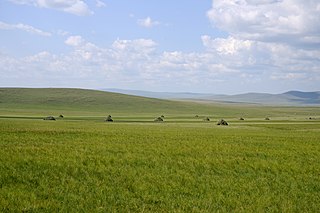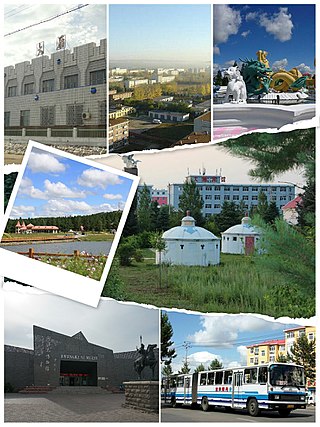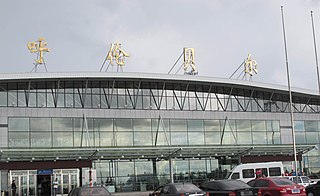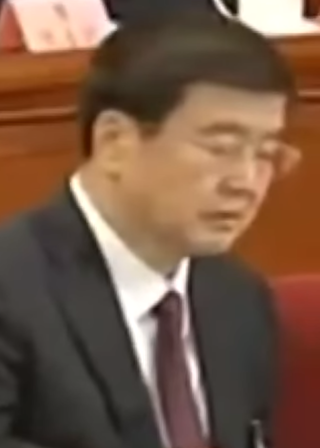Hailar may refer to:
- Hailar District, district (former city) in Inner Mongolia, China
- Hailar River, part of the Russia-China border
- Hailar Fortress , former Japanese military fortress, now memorial site in Hulunbuir, Inner Mongolia, China
Hailar may refer to:

Inner Mongolia, officially the Inner Mongolia Autonomous Region, is an autonomous region of China. Its border includes two-thirds of the length of China's border with the country of Mongolia. Inner Mongolia also accounts for a small section of China's border with Russia. Its capital is Hohhot; other major cities include Baotou, Chifeng, Tongliao, and Ordos.

Rehe, previously romanized as Jehol, was a former Chinese special administrative region and province centered on the city of Rehe, now known as Chengde.

Hohhot, formerly known as Kweisui, is the capital of Inner Mongolia in the north of the People's Republic of China, serving as the region's administrative, economic and cultural center. Its population was 3,446,100 inhabitants as of the 2020 census, of whom 2,944,889 lived in the metropolitan area consisting of 4 urban districts plus the Tümed Left Banner.

The Argun or Ergune is a 1,620-kilometre (1,010 mi) long river that forms part of the eastern China–Russia border, together with the Amur. Its upper reaches are known as the Hailar River (海拉尔河) in China. The Argun marks the border between Russia and China for about 944 kilometres (587 mi), until it meets the Amur.

Air Changan is a Chinese domestic airline. Its main operating base is Xi'an Xianyang International Airport, serving several cities in Shaanxi Province. Initially an independent carrier, Air Changan merged with Hainan Airlines in 2000 and was later absorbed into that airline. Air Changan resumed service as an independent airline in May 2016, providing flights to four Chinese cities with three Boeing 737-800 aircraft.

Hulunbuir or Hulun Buir is a prefecture-level city in northeastern Inner Mongolia, China. Its administrative center is located at Hailar District, its largest urban area. Major scenic features are the high steppes of the Hulun Buir grasslands, the Hulun and Buir lakes, and the Khingan range. Hulun Buir borders Russia to the north and west, Mongolia to the south and west, Heilongjiang province to the east and Hinggan League to the direct south. Hulunbuir is a linguistically diverse area: next to Mandarin Chinese, Mongolian dialects such as Khorchin and Buryat, the Mongolic language Daur, and some Tungusic languages, including Oroqen and Solon, are spoken there.

Hailar District, formerly a county-level city, is an urban district that serves as the seat of the prefecture-level city Hulunbuir in northeastern Inner Mongolia, China. Hulunbuir, due to its massive size, is a city in administrative terms only, being mainly grassland and rural.

Xing'an refers to a former province, which once occupied western Heilongjiang and part of northwest Jilin provinces of China. The name is related to that of the Greater Khingan Mountains. Another name used for this land was Barga, which is also the name used for the western part of the province, the Barga district.
Banner is a type of administrative division, and may more specifically refer to:

Ewenki Autonomous Banner or Evenk Autonomous Banner is an autonomous banner that lies on the border between northwestern Greater Khingan and Hulun Buir grasslands and directly south of the urban district of Hailar in the prefecture-level city of Hulunbuir, China. The autonomous banner has an area of 19,111 km2 (7,379 sq mi), and a population of 136,832 as of 2019. The banner's seat of government is the town of Bayan Tohoi. The most populous town in the banner is Dayan, which was once Dayan Mining Area as an administrative division and is now the main part of an industrial district also named Dayan Mining Area, has an area of 443 square kilometres (171 sq mi) and a population of about 73,000.

Oroqen Autonomous Banner is an autonomous banner that lies directly south of the urban district of Hailar in the prefecture-level city of Hulunbuir. It covers an area of 60,378 square kilometres (23,312 sq mi). As of the 2010 census, there were 223,752 inhabitants with a population density of 4.84 inhabitants per km2.

Yakeshi is a county-level city of Hulunbuir, Inner Mongolia, China.

Hulunbeier Hailar Airport is an international airport serving Hailar District of Hulunbuir, a prefecture-level city of Inner Mongolia, China. The airport was formerly called Hailar Dongshan Airport (海拉尔东山机场) until it was renamed on 1 January 2011.
Chahar or Chakhar may refer to:

Bagatur or Bater is a Chinese Communist Party politician of Mongol ancestry, formerly serving as the Chairman of the National Ethnic Affairs Commission. A career party functionary with background in the Communist Youth League, Bagatur steadily ascended the ranks of government, spending his entire career in Inner Mongolia. Between 2009 and 2016, he served as Chairman of Inner Mongolia.

Old Barag Banner is a banner of northeastern Inner Mongolia, China. It is located 28 kilometres (17 mi) from Hailar District, the administrative centre of Hulunbuir City, which administers this banner.
Merse was an Inner Mongolian politician, best known as a founder of the Inner Mongolian People's Revolutionary Party (IMPRP). He was a Daur from a noble family native to Hulunbuir.
The National Winter Games of China is a nationwide Chinese winter sports competition typically held every 4 to 5 years in conjunction with the National Games of China. The 2016 games featured 1,388 participants from 52 delegations, including Hong Kong and Macau. The 2020 winter games, which were to take place in February in Inner Mongolia, have been postponed to 2024 due to the global COVID-19 pandemic.

Jalainur District or Zhalainuo'er District, an urban district under Manzhouli's administration, is listed as a district of Hulunbuir officially and located in the northeast of Inner Mongolia.

The Hailar–Zhangjiakou Expressway, designated as G1013 and commonly referred to as the Haizhang Expressway, is an expressway in China that connects the cities of Hulunbuir, Inner Mongolia, and Zhangjiakou, Hebei. The expressway is a spur of the G10 Suifenhe–Manzhouli Expressway.